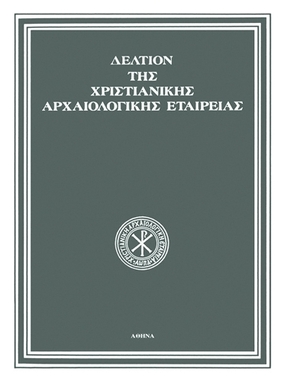Άγνωστο τρίπτυχο του Γεωργίου Κλόντζα και ο αποδέκτης του
Part of : Δελτίον της Χριστιανικής Αρχαιολογικής Εταιρείας ; Vol.38, 1999, pages 335-344
Issue:
Pages:
335-344
Parallel Title:
An Unpublished Triptych by Georgios Klontzas and its Recipient
Section Title:
Articles
Abstract:
he small work of art presented in this study has notpreviously been noted or published by scholars. It is thecentral wood-carved panel of a Cretan triptych (23.5 x 13.5cm), now dismembered, held in the J.F. Willumsens Museum, Frederikssund, Denmark.Artist, collector, and one of the first modern art historiansto study the formative period of El Greco, Willumsen boughtthe work in question in 1914 in North Italy (Brescia).The work shows the Virgin and Child (of the Vrephokratousa type), with the Virgin being crowned by flying angels.In the lower left corner of the scene is painted a coat ofarms: a white (=silver) hat, with spiral-shaped top (reminiscent of that worn by the Doge of Venice), is depicted on adark blue background. The coat of arms belongs to thenoble Tiepolo family, members of which served as officialsin Venetian-controlled Crete in the sixteenth century.It is likely that the recepient of the original triptych wasErmolao (Venetian: Almorò) Tiepolo, Duke of Crete from1578 to 1580. Furthermore, after a careful analysis of theiconographie details in the painting, it is proposed that thetriptych was commissioned as a gift for Ermolao Tiepolo onthe occasion of the completion of his term of office on Crete.In fact we know of other cases where works of art, encomiasticdiscourses and other literary or historical works werededicated to departing Venetian dignitaries of the island.The triptych is distinguished for the high quality of itspainting, the delicate treatment of detail and finely craftedstylistic features. And the flowing rendering of the figuresand a mannerist feel to the whole, together with the closelyfolded drapery and subtly blended colours all point to thework of Georgios Klontzas, a major Cretan artist with aparticular talent for miniature detail and manuscript illuminations. If we accept this attribution of the work, it ispossible now to add yet another triptych to the known output of Georgios Klontzas, and to date it with considerablecertainty to 1580. Once again, the reputation of the painteris confirmed for us, as well as the high esteem in which hewas held by the high society of Venetian-ruled Candia.
Subject:
Subject (LC):




